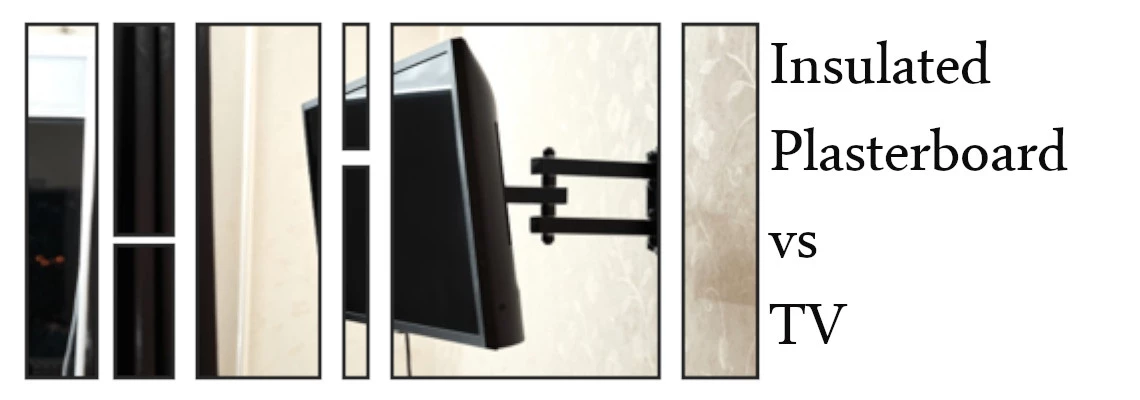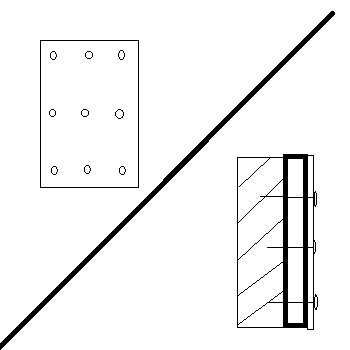
HANGING TV ON INSULATED PLASTERBOARD*
Nowadays, larger TVs, typically 55 inches and above, are commonly hung on walls. This is primarily for two reasons: firstly, for safety in case of accidental falls, and secondly, to save space in rooms that always seem to be lacking it.
The purchase of a large TV isn't the end of the story; the real challenge lies in its installation. While mounting on a sturdy wall like brick shouldn't be problematic, mounting on insulated plasterboard might present some difficulties.
Therefore, this short article is dedicated to addressing this specific challenge. By reading further, you'll discover the right way to mount a TV on insulated plasterboard.
IS IT SAFE TO FIX TV ON INSULATED PLASTERBOARD / INSULATED PLASTERBOARD STRETCHING RESISTANCE
Mounting a TV on insulated plasterboard raises safety concerns and questions about the material's ability to withstand stress. The compressive strength of PIR insulation, often around 120kPA, might not guarantee ample support for a heavy TV on this surface.
Manufacturers like Kingspan, Unilin, or Celotex usually don't specify stretching resistance for their insulated plasterboards, understandable since these boards typically don't endure significant stretching forces in regular use.
It's essential not to overestimate the insulated plasterboard's strength based solely on its compact structure. While they may appear robust, heavy items detaching from the wall often remove the outer plaster layer, affecting the entire structure, including the gypsum board connected to the insulating core.
When mounting a heavy TV on insulated plasterboard, it's crucial to consider the load-bearing capacity of the gypsum board itself rather than relying on the insulation core. This is especially vital because insulation materials are lightweight and should not be the primary support for heavy objects like a 55-inch TV.
MOUNTING A TV ON DOT AND DAB INSULATED PLASTERBOARD
To understand how to correctly mount a TV on insulated plasterboard, you need to know the weight of the TV you are dealing with. A 55-inch TV typically weighs around 17kg without the mounting bracket. Therefore, it can be assumed the entire setup will weigh around 20kg.
Manufacturers allow for hanging loads up to 40kg per 1 metre length of wall directly on the gypsum board, including insulated plasterboard. In theory, mounting the TV on insulated plasterboard affixed using the Dot and Dab technique should be sufficiently safe. However, the issue lies in this method.
 The Dor&Dab technique involves attaching insulated plasterboard to solid walls by using a point-to-point adhesive method. Consequently, it's easy to visualise that the entire weight placed on the insulated plasterboard may tend to detach the boards at their weakest point – the adhesive's contact area with the wall.
The Dor&Dab technique involves attaching insulated plasterboard to solid walls by using a point-to-point adhesive method. Consequently, it's easy to visualise that the entire weight placed on the insulated plasterboard may tend to detach the boards at their weakest point – the adhesive's contact area with the wall.
This area is relatively small, maybe a maximum of 0.5m² in comparison to the 2.88m² total surface area of the insulated plasterboard. This indicates that the surface area where the insulated plasterboard contacts the solid walls is only 0.5m².This is particularly concerning because some areas of the adhesive might not be strongly bonded.
These spots are the most likely to come loose, along with the TV!
When installing TV on a wall with insulated plasterboard secured by Dot and Dab technique, using the extra screws is crucial. This helps avoid the board coming loose at the points where the adhesive connects with the wall. Consider using at least 4-5 screws in these areas during the installation process for added security.
MOUNTING A TV ON MECHANICALLY FIXED INSULATED PLASTERBOARD
The situation changes significantly when aiming to mount a TV on insulated plasterboard that's been previously fixed to the wall using a timber or metal frame.
In this scenario, the external surface of the insulated plasterboard is physically secured to the wall structure, requiring substantial force to detach it from the wall. Consequently, mounting a TV on insulated plasterboard fixed to a timber or metal frame should be relatively straightforward and quick.
 The key to success lies in finding the area where the framework exists and directly attaching the TV bracket to the wall structure.
The key to success lies in finding the area where the framework exists and directly attaching the TV bracket to the wall structure.
To find the wall structure, you can remove the skirting board and drill small holes in the insulated plasterboard every 30mm until you feel resistance, which usually indicates you've hit the first beam.
Once you've found the first beam, locating the rest shouldn't be too hard, as they're often spaced around 400mm or 600mm apart.
Builders can often spot the locations of beams by noticing screw placements in the wall, indicating the presence of beams.
It might be a good idea to invite such a person over for a cup of tea to seek their advice.
In the case of a metal frame, if the thickness of the insulated plasterboard is not more than 52.5mm, a metal detector should be capable of detecting the metal and indicating the spot where we should screw in the TV bracket.
CONCLUSION
When mounting a TV on insulated plasterboard, several considerations come into play. In the case of dot and dab fixing, there's a risk of inadequate bonding, particularly at the areas where the board meets the wall structure. Using appropriate length screws in these locations is crucial for securing the board to the wall structure.
However, when the insulation is fixed to a wooden or metal frame, the TV installation process is usually simpler and safer. Locating the structural beams, often detected by resistance during drilling, is key to a successful installation.
Ultimately, seeking guidance from experienced construction professionals can greatly facilitate and secure the TV mounting process on insulated plasterboards. Their insights and expertise can provide invaluable tips during installation.
Related articles:
MASTERING INSULATED PLASTERBOARD FIXINGS: BEST PRACTICES FOR SOLID WALLS
HOW TO INSTALL INSULATED PLASTERBOARD?
HOW TO CUT A PIR INSULATION BOARD?
5 BENEFITS OF INSULATED PLASTERBOARD
*All the information provided in the content published on Insulationgo blog is for informational and educational purposes only. Insulationgo LTD makes every effort to ensure the accuracy and timeliness of the content, but we do not assume any responsibility for any errors or omissions.
The information presented on this blog should not be considered as professional advice or a substitute for consulting relevant experts. Before making any purchase decisions or taking action based on the information presented here, it is strongly recommended to contact the product manufacturer directly to verify the details and ensure its suitability for your specific needs.
Any descriptions, drawings, photographs, data, proportions, weights, measured values etc. given herein may change without prior notice and do not constitute the agreed contractual quality of the products. It is the responsibility of the recipient of all products to ensure that any proprietary rights and existing laws and legislation are observed.
By using this blog, you acknowledge and agree that Insulationgo LTD shall not be held liable for any damages, losses, or inconveniences arising from the use or reliance on the information provided herein. This limitation of liability applies to all users of the blog, including but not limited to visitors, readers, and subscribers.










































































































